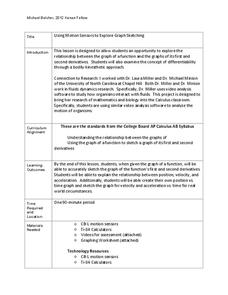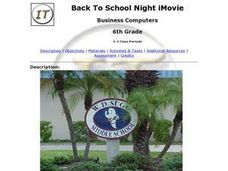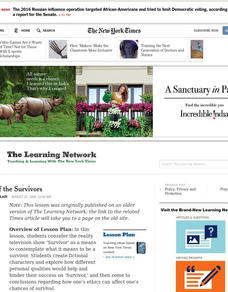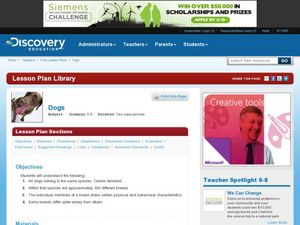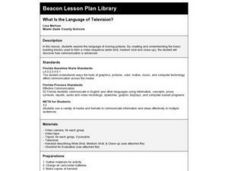Kenan Fellows
Using Motion Sensors to Explore Graph Sketching
Get moving to a better understanding of graphs of derivatives. Using motion sensors, scholars vary their velocities to create graphs of the first derivative of a function. The activity challenges groups to first create a script of the...
Teaching Tolerance
Listen Up! PSA for Change
Challenge scholars to speak up about a topic by creating a public service announcement or social media blitz about an issue they feel passionate about. Have them research their issues, then decide the best way to take their messages to...
Kenan Fellows
Unit 2: DNA Analysis
Ever wonder how they solve those mysterious murders in TV crime dramas? The second of four units in a Biotechnology series introduces scholars to the many methods of DNA analysis. Pupils create and run their own gel electrophoresis...
Curated OER
Putting the Sitcom into Perspective
Young scholars identify and compare similar characters and situations in stories and dramas from and about various cultures, illustrate with classroom dramatizations, and discuss how theater reflects life.
Curated OER
Back To School Night iMovie
Learners work collaboratively to take and download digital images, use iMovie software, and create an iMovie to show at a Back To School Night event. They discuss how to organize the information into a clear and cohesive movie. Then,...
Curated OER
Watch and Learn
Students explore a particular problem with the development of new television shows and create original reality-based educational programming.
Curated OER
Pop on the Block
Students consider what makes a movie, television show, musical talent, or artist a cult classic and create descriptive lists of items from these phenomena that may be sold at auction.
Curated OER
Making 'Friends'
Young scholars read "Fans Gear Up to Say Goodbye to 'Friends'" from The New York Times and discuss the elements of the sitcom 'Friends' that made it such a success. After brainstorming reasons for 'Friends' popularity, students work in...
Curated OER
Fittest of the Survivors
students consider the reality television show 'Survivor' as a means to contemplate what it means to be a survivor. They create fictional characters and explore how different personal qualities would help and hinder their success on...
Curated OER
Dogs- Canine Familiaris
Students research dog species and breeds. In this dog lesson, students discuss breed of dogs, their personal experiences, and complete a Venn Diagram comparing breeds. Students use the research to analyze television shows or movies which...
Curated OER
Careers in Television
Students discuss and research how a news program is produced. They watch a web based video before working in small groups to produce a news program. They role play different jobs as they produce the program to share with at least one...
Curated OER
Lesson 11- Vaudeville: On With the Show
Pupils create comedy skits based on family or domestic situation. They observe their own families, write a script for a vaudeville type skit, and perform the skit.
Curated OER
Fearing the Fear Factor
Students write a reaction paper on the topic: "Reality shows like 'Fear Factor' are dangerous/nothing to worry about because...." Students respond to the situation Akron, Ohio's First Energy Corporation being labeled irresponsible after...
Overcoming Obstacles
Problem Solving at Home
The final lesson in the "Problem Solving Module" focuses on finding creative solutions to problems that might arise at home. Individuals then create a storyboard that illustrates how they would apply the six-step problem-solving process...
Curated OER
Are You Plugged In?
Students develop an awareness of one's own media habits. Make connections between ads and one's own consumer behavior. They track their current TV and/or Internet viewing habits and video game time by keeping a TV Diary for one week.
Curated OER
What Is the Language of Television?
Sixth graders explore the language of moving pictures. By creating and understanding the basic building blocks used to form a video sequence (wide shot, medium shot and close-up),they discover how communication is enhanced. A great,...
Curated OER
A La Tele
Students read a current television guide from French television. In groups, they practice and review the twenty-four hour clock and determine when a show they want to watch is on in Europe. They create a list of words they know and do...
Curated OER
Creating a Digital Newspaper
Young scholars create a digital newspaper. In this digital newspaper instructional activity, students review the sections of a newspaper and brainstorm ideas for their paper. Young scholars complete a schools news report, student...
Curated OER
Creating Characters: Movement
Students compare two characters and role-play how they would perform various actions. They view and discuss a video, list opposite descriptions for the two girls in the video, and role-play the opposites.
Curated OER
Survival of the Fittest Microbes
Students explore the harsh conditions of Spain's Rio Tinto River and research the microbes that nonetheless manage to thrive there. They synthesize their knowledge by creating a reality television show set in the Rio Tinto with microbes...
Curated OER
Media Literacy Final Project
Students meet as a class to discuss a variety of media literacy topics before breaking into groups to conduct research on one aspect of the topic. In order to gather information, they watch episodes of the Simpson's television show and...
Curated OER
Great Wall of China
Students investigate the construction of the Great Wall of China. In this Chinese history lesson, students research print and Internet sources about the contributions of the Qin, Han, Tang, and Ming Dynasties. Students...
Curated OER
Civil Rights Video Essay
Students investigate a decade of American history when the civil rights movement was a focus of national attention. They create a video essay about a person or event that played an important role in shaping the civil rights movement.
Cornell University
Forensic Science: Case of the Missing Diamond Maker
Someone stole a diamond-making machine. Who done it? Scholars use forensic science at six different stations to determine the culprit. They analyze fingerprints, use their senses, and complete chemistry experiments to determine the...
